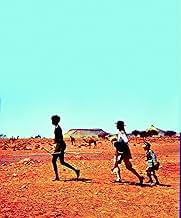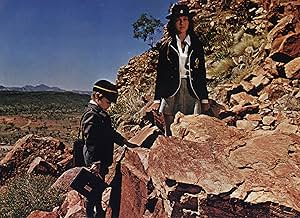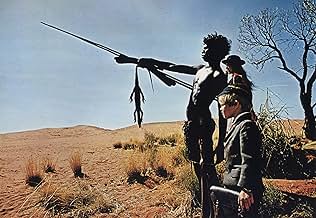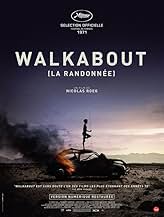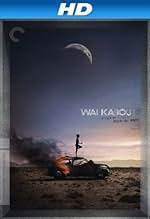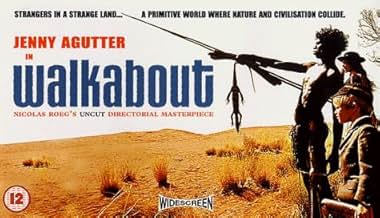AVALIAÇÃO DA IMDb
7,6/10
29 mil
SUA AVALIAÇÃO
Dois irmãos criados na cidade estão confinados na Austrália, onde aprendem a sobreviver com a ajuda de um menino indígena.Dois irmãos criados na cidade estão confinados na Austrália, onde aprendem a sobreviver com a ajuda de um menino indígena.Dois irmãos criados na cidade estão confinados na Austrália, onde aprendem a sobreviver com a ajuda de um menino indígena.
- Direção
- Roteiristas
- Artistas
- Prêmios
- 1 vitória e 1 indicação no total
David Gulpilil
- Black Boy
- (as David Gumpilil)
Robert McDarra
- Man
- (as Robert McDara)
Peter Carver
- No Hoper
- (as Pete Carver)
Noeline Brown
- German Scientist
- (as Noelene Brown)
George Roubicek
- Radio Announcer
- (narração)
- (não creditado)
- Direção
- Roteiristas
- Elenco e equipe completos
- Produção, bilheteria e muito mais no IMDbPro
Avaliações em destaque
Goodness gracious it's amazing how many reviewers missed the most obvious aspect of the film. This tale is about innocence and it approaches that from many different angles. As for Roeg practicing camera tricks-maybe today these are tricks but at the time the style was a pioneering method of telling and showing psychological elements, wasted on todays audiences. Roeg presents innocence in juxtaposition with the hardness and neuroses of society, not as WHITEMAN BAD but as society, modern society makes us very neurotic by taking away our innocence. Roeg makes an brilliant point and stylizes a mostly nonverbal experience by letting us journey with children all on the cusp of some new stage of growth. This movie is a small masterpiece!!
Although this is a sound film, and the characters talk to one another, this film could have been made just as well in the 1920s. It does not really need sound.
The film is about nature, and man's relationship with it. If a civilised person were left out in the desert, then they would soon die. But, as this film shows, there are people and creatures living out there quite happily.
The film has been criticised for having a weak beginning and a weak end. But where does the story of this film start? And where and when would you end it? Yes you can end it when the two children get back to civilisation. But does the story end there? No. Because of their experiences, things are never going to be the same again. And for them, the story has not finished, it is only just beginning.
I have seen this film several times and I notice something different every time I see it.
The film is about nature, and man's relationship with it. If a civilised person were left out in the desert, then they would soon die. But, as this film shows, there are people and creatures living out there quite happily.
The film has been criticised for having a weak beginning and a weak end. But where does the story of this film start? And where and when would you end it? Yes you can end it when the two children get back to civilisation. But does the story end there? No. Because of their experiences, things are never going to be the same again. And for them, the story has not finished, it is only just beginning.
I have seen this film several times and I notice something different every time I see it.
As far as comments about Roeg's going overboard with his message of "nature/aborigine good, industrialisation/white men bad," this is a simplistic way of reading it. First of all, every director has his or her own style, and Roeg started as a cinematographer--his movies tend to contain long, meditative (or, boring, depending on one's view) visual passages. Roeg floods the screen with cascades of images, by turns repetitive and contrasting, much as a poet uses the sounds and rhythms of words, as well as their semantic content, to create "meaning" in the context of the poem.
To expect Roeg not to dwell on images is to expect Tolstoy not to go off on 20-page rants about how the lack of Napoleon would necessitate another to fill his historical role. One overlooks idiosyncracies in one's friends.
I found the movie much more powerful than I expected. My only disappointment with the Criterion DVD release is with the commentaries. I would love to have heard more about the story, and it would have been nice to have heard from David Gulpilil, whose role as the aborigine was a watershed in Australian cinema, as noted in the IMDb article on his career.
To expect Roeg not to dwell on images is to expect Tolstoy not to go off on 20-page rants about how the lack of Napoleon would necessitate another to fill his historical role. One overlooks idiosyncracies in one's friends.
I found the movie much more powerful than I expected. My only disappointment with the Criterion DVD release is with the commentaries. I would love to have heard more about the story, and it would have been nice to have heard from David Gulpilil, whose role as the aborigine was a watershed in Australian cinema, as noted in the IMDb article on his career.
10Tophee
Superb cinematography, the Australian outback comes alive in this film of self discovery and regret. Agutter plays the English girl brilliantly, incapable of comprehending anybody or anything that doesn't conform to her middle-class values and upbringing. Roeg is also excellent as her brother, adapting to each and every change in circumstance as only children can. I have watched this movie many times, and always get something new from it. Highly recommended to anyone, although parents might want to watch it before letting their kids see it.
A remarkably potent little film about a couple of very proper English kids who get lost in the Australian outback and hitch up with an aborigine boy on his initiation quest (or "walkabout"). My mom took me to see it when I was ten, and I've been haunted by it ever since. With some understated yet disturbing themes of alienation and violence, as well as the first scenes of full nudity I had ever witnessed on screen, I've sometimes wondered whether mom knew what she was getting into when she took me along. According to the trailer in the letterbox edition, Parents' Magazine recommended the film "without reservation" for young and old alike, because it depicts "facts of life." While that may be true, times have changed, and I can't imagine anyone today describing this subtle and unsettling story as "family fare." Incredibly tame, on its face, by today's standards of sensory overload, its essential world-weariness and maturity is no longer a didactic priority in our age of overconfidence. Watching it recently, I was on guard for signs of the myth of the "noble savage"--the hackneyed, simplistic, and generally hypocritical pretension that pre-industrial and non-Western peoples are morally superior to decadent moderns, which is demeaning to both modern and "savage" alike. There are instances of it here--most notably when a couple of rifle-toting, four-wheeling hunters decimate the landscape--but the overall emphasis is on the parallels between aborigine and Western life. Even scenes of the transience and decay of modern civilization are mirrored by the life-and-death cycles of the wilderness. With so many underlying similarities, the real question is why the teenaged English girl cannot embrace, figuratively and literally, the young black man who has saved her life and provided so selflessly for her, even while her younger brother, in all his innocence, has never doubted that they are a family. Is it race? Culture? Or does it reach to more fundamental questions of boy and girl, man and woman, human and human? This film has held up remarkably well over the past 30 years, and is well worth a look.
Você sabia?
- CuriosidadesLuc Roeg was actually sun-burnt in the scene where the aboriginal boy treats his back by rubbing him with fat from a wild boar. Director Nicolas Roeg thought it would make a good scene for the film so he picked up the camera and shot it.
- Erros de gravaçãoThe credits name the actor playing "Black Boy" as David Gumpilil. It should be David Gulpilil.
- Citações
Narrator: [last lines - from "Poem XL" by A.E. Housman's "A Shropshire Lad"] Into my heart an air that kills, From yon far country blows: What are those blue remembered hills, What spires, what farms are those? That is the land of lost content, I see it shining plain, The happy highways where I went, And cannot come again.
- Cenas durante ou pós-créditosAfter the credits, there is a flash of white light on the screen and as it becomes a black screen, radio tuning is heard while the words "rien ne va plus" are shown.
- Versões alternativasA director's cut of this movie was released in 1997 with 5 additional minutes. This cut is identical to the original British release version (100 minutes): the film was shortened by five minutes for its original American release.
- ConexõesEdited into Terror Nullius (2018)
- Trilhas sonorasElectronic Dance
Written and performed by Billy Mitchell
Principais escolhas
Faça login para avaliar e ver a lista de recomendações personalizadas
- How long is Walkabout?Fornecido pela Alexa
Detalhes
- Data de lançamento
- Países de origem
- Idiomas
- Também conhecido como
- Encuentro de dos mundos
- Locações de filme
- Empresas de produção
- Consulte mais créditos da empresa na IMDbPro
Bilheteria
- Orçamento
- AU$ 1.000.000 (estimativa)
- Faturamento bruto mundial
- US$ 1.888
Contribua para esta página
Sugerir uma alteração ou adicionar conteúdo ausente


